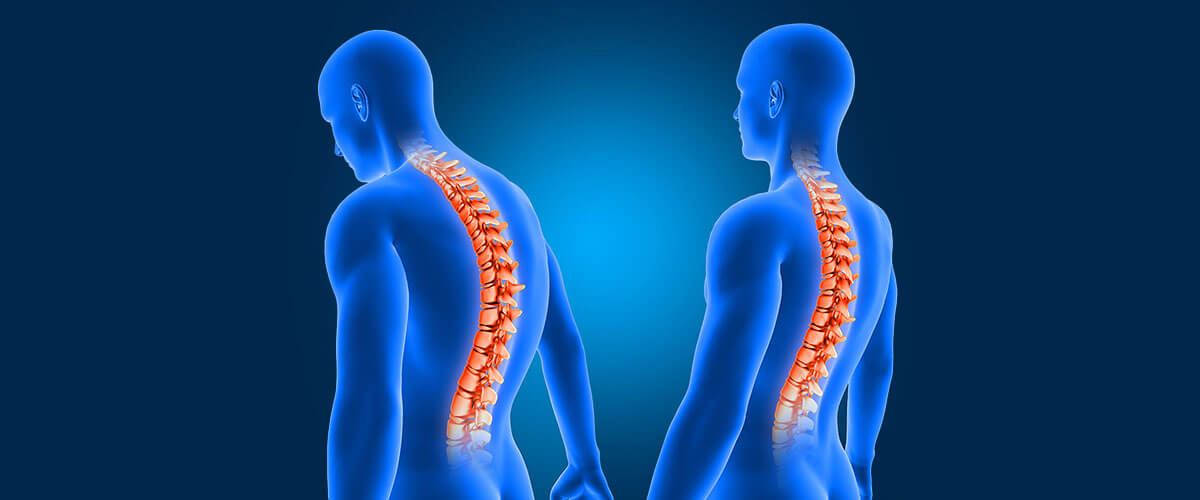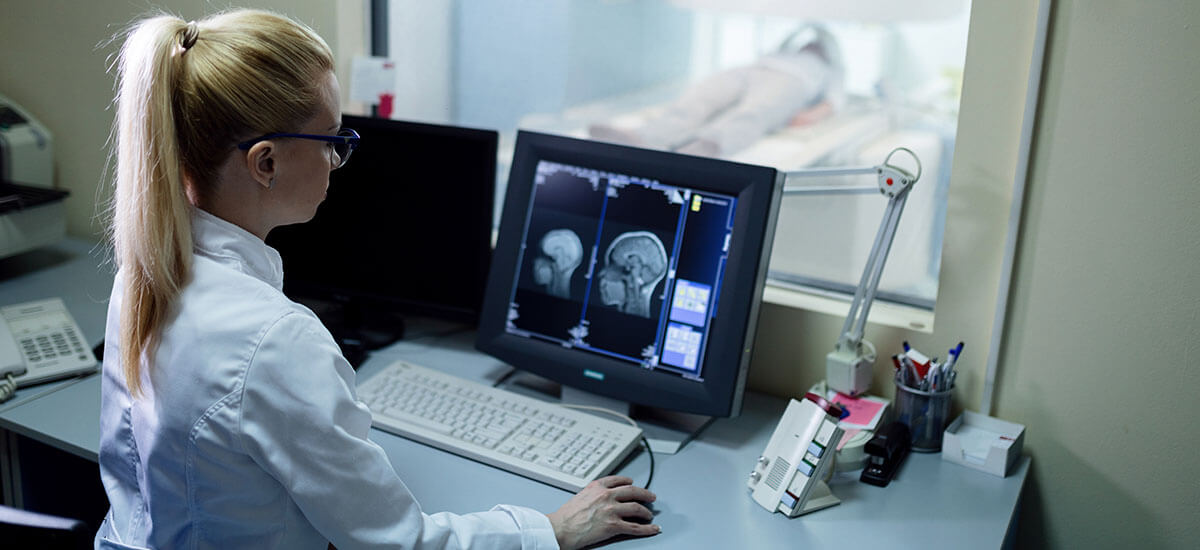
We collect basic website visitor information on this website and store it in cookies. We also utilize Google Analytics to track page view information to assist us in improving our website.

Technology has brought conveniences for many professions, but for one, it’s been a bit of a pain in the neck. As radiologists adopted a filmless workflow, without paying much attention to ergonomics, increased work pressure lead to more fatigue, injuries, and radiology errors.
Radiologists are responsible for reading and analyzing images to produce clinical interpretations, so keeping errors minimal is critical.
We don’t need a lot of research to tell us that medical errors can be costly in the worst possible ways, but studies do prove it. Recognizing that patient safety is paramount, ergonomics experts have taken a deep dive into studying the role of ergonomics in radiology.
This has lead to a slow but steady change in radiology training and protocols, introducing ergonomic best practices to the field.
Like any other career field, human factors in radiology are the biggest cause of errors.
One of the foremost of which is burnout. It has a number of symptoms, including loss of job enthusiasm, extreme emotional exhaustion, severe depersonalization, and a low sense of personal accomplishment. An unforgiving workload is one of the leading reasons for burnout among physicians across all medical specialties.
Poor ergonomic design in reading rooms is equally important when it comes to diagnostic imaging experts. Bad workspace and workstation design increases work-related injuries, such as repetitive strain injuries (RSIs) for radiology staff at a medical facility.
Other ergonomics-related factors causing radiology errors are eye and physical fatigue. Severity of eye strain and blurred vision increases when the number of images to be read increases, making it hard for the radiologist to maintain focus. Physical fatigue can be caused by prolonged concentration, comprehensive image review, varied image loads, demands to read quickly, and reporting using 3D visualization of results.
Lacking an ergonomic radiology workstation, staff must make slight, unconscious physical changes to adjust with the conditions. Having to do so continuously and for long hours creates physical stress, which reduces productivity and raises the risk of errors.
Physical fatigue can lead to shorter viewing times, leading to hasty decision making.
Poor ergonomics also cause work disruptions due to poorly managed radiology equipment and technology. Constant breakdowns can lead to a break in concentration and frustration, leading to errors.
Rates of false-positives and false-negatives in radiology have been estimated to be as high as 30%.
Burnout usually has deeper and profound consequences on radiology productivity. A loss of interest in work may make imaging experts careless and less concerned about the outcome of each case or task.
Radiologists experiencing burnout may make more errors or not be as productive as needed, causing potential patient injury and misdiagnosis.
One of the most common errors are errors of omission (false-negatives or missing a finding) and false-positives.
Physical exhaustion can interfere with the way images are perceived, leading to perceptual errors or missing abnormalities in imaging. Too much workload can cause delays in interpretation and hasty diagnoses to keep up with demand.
Diagnostic imaging errors can cost employers in terms of workforce well-being. Where some errors may be remediable if caught in time, others may not and could end up causing patients’ life.
Increasingly as research has been done on how to reduce errors in diagnostic imaging, more and more the role of ergonomics in radiology has come to the forefront.
Applying healthcare ergonomics to radiology work environments not only increases occupational health and safety — it can also go a long way in preventing errors.

Ergonomics, in general, is the science of modifying the conceptualization or structure of products to adapt them for use by people. Ergonomic interventions in radiology rooms not only study how human characteristics, like height, weight, and properties affect workflow but also how interaction with radiology equipment changes productivity.
The first step is to conduct a deep and thorough ergonomic assessment of the radiology department. An important part of adjusting the reading room and workstations is to determine ergonomic guidelines suitable to the profession.
The main ergonomic need in radiology is setting up a decent working stance at workstations. An efficient radiology workstation will provide the option to sit or remain in a neutral body position preventing stress. Diagnostic imaging experts need to sit so their hands, wrists, and lower arms are straight, in line and aligned with the floor. Radiologists need to keep their head level, looking straight ahead, only ever at a slight angle if need be. Workstations should be amenable to productivity while the person is both sitting or standing.
Seats and desks with customizable height are a crucial part of ergonomics.
Screens and other presentation gadgets should be at eye level, suitable to the user. Reviewing images should not stress the neck or force the individual to squint to see. According to ergonomics, a diagnostic imaging expert should not be required to turn their neck side to side, up or down to look at screens.
Imaging screens are heavy and your workstation should allow you to easily adjust the position and distance of your monitors.

Using an ergonomically designed keyboard and mouse can prevent unnecessary exhaustion and injury. Not only does the equipment need to be ergonomically designed, but it also needs to be placed in a manner following ergonomic principles.
Getting up and move around — it’s one of the simplest things that can be done to improve workforce well-being. Every 20 minutes or so, stand up and take a couple of moments to stroll around, perhaps to the water cooler to grab a drink, maybe glance out a window, or anything else to get out of the seat.
Depending on each diagnostic imaging expert’s needs, they may require a specific set of ergonomic accessories, for example, headsets or a footrest.
Reading rooms aren’t just for reading images. This space in healthcare settings has evolved to include room for referring physicians, a viewing area, and a work area. The work area refers to the zone with the workstations. Radiologists often refer to a workstation specifically as the picture archiving and communication system (PACS) equipment.
Each physical element, like work surface, chair, monitor, input device, etc., that makes up a workstation should be adjustable. Reading room workstations are typically shared by several individuals with varying ergonomic needs and requirements, so they should be capable of a range of adjustments.
Lighting control is the reading room's single most important design consideration. Improper lighting can lead to headaches and other injuries. Each area within the reading room should have independent lighting controls. Room illumination levels should be approximately equal to the illumination level of the primary reading monitor.
Two distinct types of lighting should be considered in reading rooms. One is dimmable ambient lighting, which provides low levels of evenly distributed background elimination for image interpretation. This lighting, like others, should be adjusted for higher illumination for radiology equipment maintenance and housekeeping activities.
Indirect ambient lighting that bounces off a surface, such as the ceiling, is generally preferred over direct lighting where the source of illumination is reflected by the monitor. A ceiling height of 9' 6" or higher may be required for proper installation of indirect lighting.
The second type of lighting that falls under ergonomic guidelines is supplemental task lighting, which is in addition to local lighting. This type of lighting is used for doing manual tasks, such as writing and completing paperwork without disturbing colleagues. Supplemental lighting should be narrowly focused, perhaps by being mounted on workstations or on portable fixtures.
Just as sources of light can be distracting for radiologists, noise can be a major disturbance, too. Reading room acoustic control has become an important factor for creating efficient form, function, and flow.
Two types of reading room sounds should be addressed under ergonomic guidelines. The first is noise from other computers (think the clackity clack of keyboards). The second type of noise is discernable conversation.
Using sound absorbing materials for walls, floors, and other finishes can generally control noise. Sound-absorbing partitions can also be effective in masking noise and encouraging collaboration and physician visits to reading rooms.
When constructing an ideal reading room, it should be configured in such a way that it allows for future developments in reading processes and technology.
Virtual reality and visual immersion studios, while in limited use today, may become more common in the future, hence, there should be room to allow for expansion into these new-age tools.
Workforce well-being increases occupational and patient health and safety.
A thriving healthcare system provides a workplace that values diagnostic imaging experts for the strenuous and grueling work they do. Designing an ergonomically sound reading room gives radiology staff the chance to be productive and healthy.